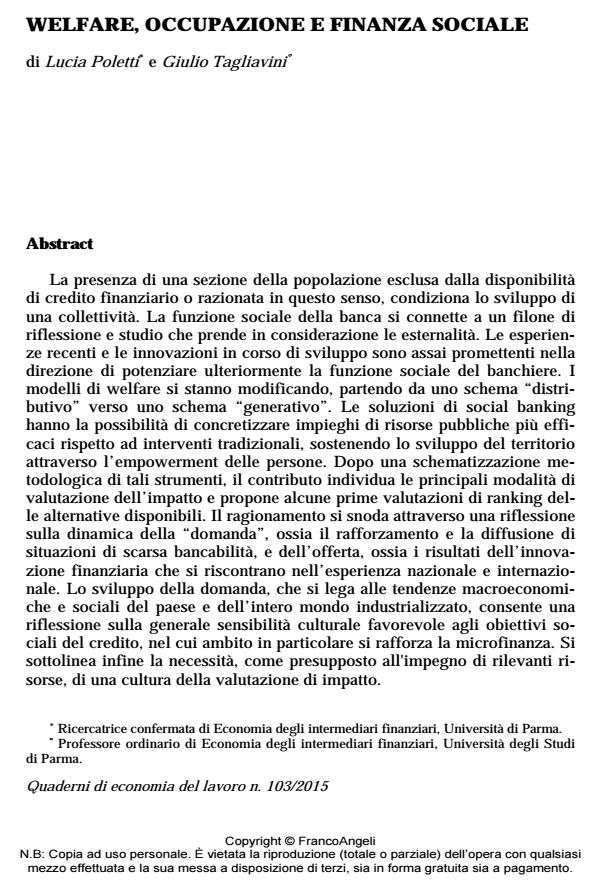Welfare, occupazione e finanza sociale
Titolo Rivista QUADERNI DI ECONOMIA DEL LAVORO
Autori/Curatori Lucia Poletti, Giulio Tagliavini
Anno di pubblicazione 2015 Fascicolo 2015/103
Lingua Italiano Numero pagine 23 P. 261-283 Dimensione file 79 KB
DOI 10.3280/QUA2015-103012
Il DOI è il codice a barre della proprietà intellettuale: per saperne di più
clicca qui
Qui sotto puoi vedere in anteprima la prima pagina di questo articolo.
Se questo articolo ti interessa, lo puoi acquistare (e scaricare in formato pdf) seguendo le facili indicazioni per acquistare il download credit. Acquista Download Credits per scaricare questo Articolo in formato PDF

FrancoAngeli è membro della Publishers International Linking Association, Inc (PILA)associazione indipendente e non profit per facilitare (attraverso i servizi tecnologici implementati da CrossRef.org) l’accesso degli studiosi ai contenuti digitali nelle pubblicazioni professionali e scientifiche
La presenza di una sezione della popolazione esclusa dalla disponibilità di credito finanziario o razionata in questo senso, condiziona lo sviluppo di una collettività. La funzione sociale della banca si connette a un filone di riflessione e studio che prende in considerazione le esternalità. Le esperienze recenti e le innovazioni in corso di sviluppo sono assai promettenti nella direzione di potenziare ulteriormente la funzione sociale del banchiere. I modelli di welfare si stanno modificando, partendo da uno schema "distributivo" verso uno schema "generativo". Le soluzioni di social banking hanno la possibilità di concretizzare impieghi di risorse pubbliche più efficaci rispetto ad interventi tradizionali, sostenendo lo sviluppo del territorio attraverso l’empowerment delle persone. Dopo una schematizzazione metodologica di tali strumenti, il contributo individua le principali modalità di valutazione dell’impatto e propone alcune prime valutazioni di ranking delle alternative disponibili. Il ragionamento si snoda attraverso una riflessione sulla dinamica della "domanda", ossia il rafforzamento e la diffusione di situazioni di scarsa bancabilità, e dell’offerta, ossia i risultati dell’innova-zione finanziaria che si riscontrano nell’esperienza nazionale e internazionale. Lo sviluppo della domanda, che si lega alle tendenze macroeconomiche e sociali del paese e dell’intero mondo industrializzato, consente una riflessione sulla generale sensibilità culturale favorevole agli obiettivi sociali del credito, nel cui ambito in particolare si rafforza la microfinanza. Si sottolinea infine la necessità, come presupposto all'impegno di rilevanti ririsorse, di una cultura della valutazione di impatto
- Altis – Febea – Institute for Social Banking (2014). Review of Impact assessment methodologies for ethical finance.
- Andreoni A., Sassatelli M., Vichi G. (2013). Nuovi bisogni finanziari: la risposta del microcredito. Bologna: il Mulino.
- Botti F., Corsi M. (2010). A social Performance Analysis of Italian Microfinance. CEB Working Paper n. 10/020.
- C.Borgomeo&co., CamComUniversitasMercatorum (2013).Fiducia nel microcredito. Esperienze di microcredito per l’impresa ed il sociale. VII Rapporto sul microcredito in Italia (2011). Roma: Donzelli.
- Bendig M., Unterberg M., Sarpong B. (2014). Overview of the Microcredit Sector in the European Union 2012-2013. European Microfinance Network - EMN.
- Finance Watch (2014). A missed opportunity to revive “boring” finance? A position paper on the long term financing initiative, good securitisation and securities financing.
- Foschi L. (2013). Capitale sociale. In: Pizzo G., Tagliavini G, a cura di, Dizionario di microfinanza – Le voci del microcredito, Roma: Carocci.
- Fracasso G. (2013). Monti di pietà. In: Pizzo G., Tagliavini G, a cura di, Dizionario di microfinanza – Le voci del microcredito. Roma: Carocci.
- Gatti S. (2013). Banche di credito cooperativo. In: Pizzo G., Tagliavini G, a cura di, Dizionario di microfinanza – Le voci del microcredito. Roma: Carocci.
- Haldane A. G. (2015). Growing, fast and slow. Bank of England.
- Mehrotra A., Yetman J. (2015). Financial Inclusion – issues for central banks. BIS Quarterly Review. Marzo.
- Morgan J. P. (2015). Eyes on the Horizon – The Impact Investor Survey.
Lucia Poletti, Giulio Tagliavini, Welfare, occupazione e finanza sociale in "QUADERNI DI ECONOMIA DEL LAVORO" 103/2015, pp 261-283, DOI: 10.3280/QUA2015-103012